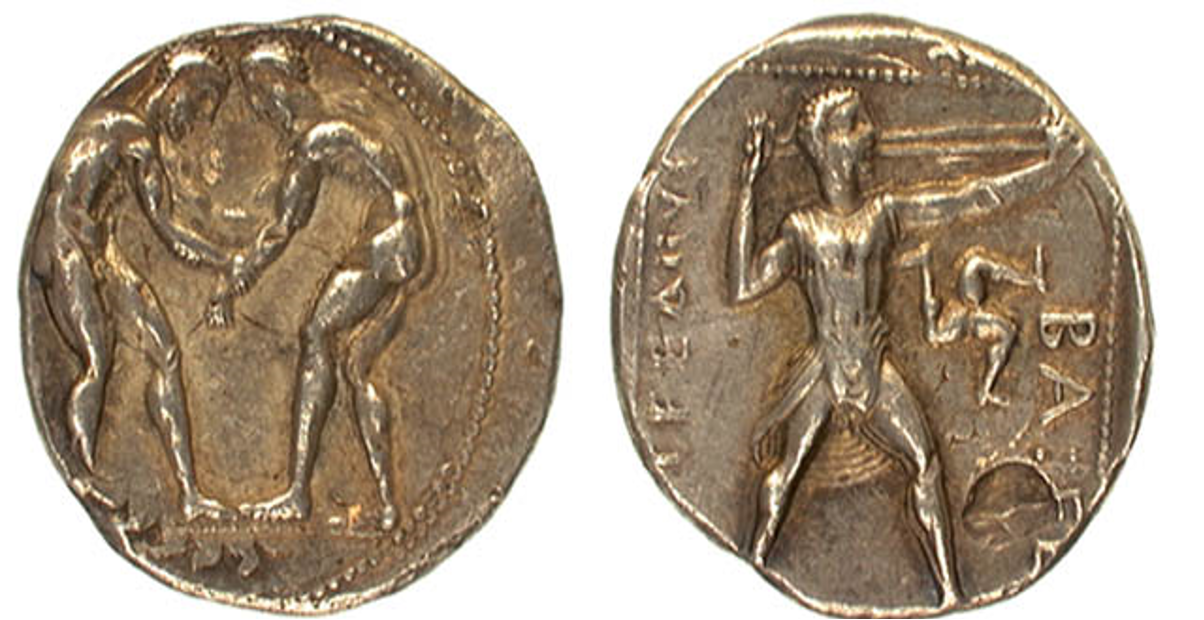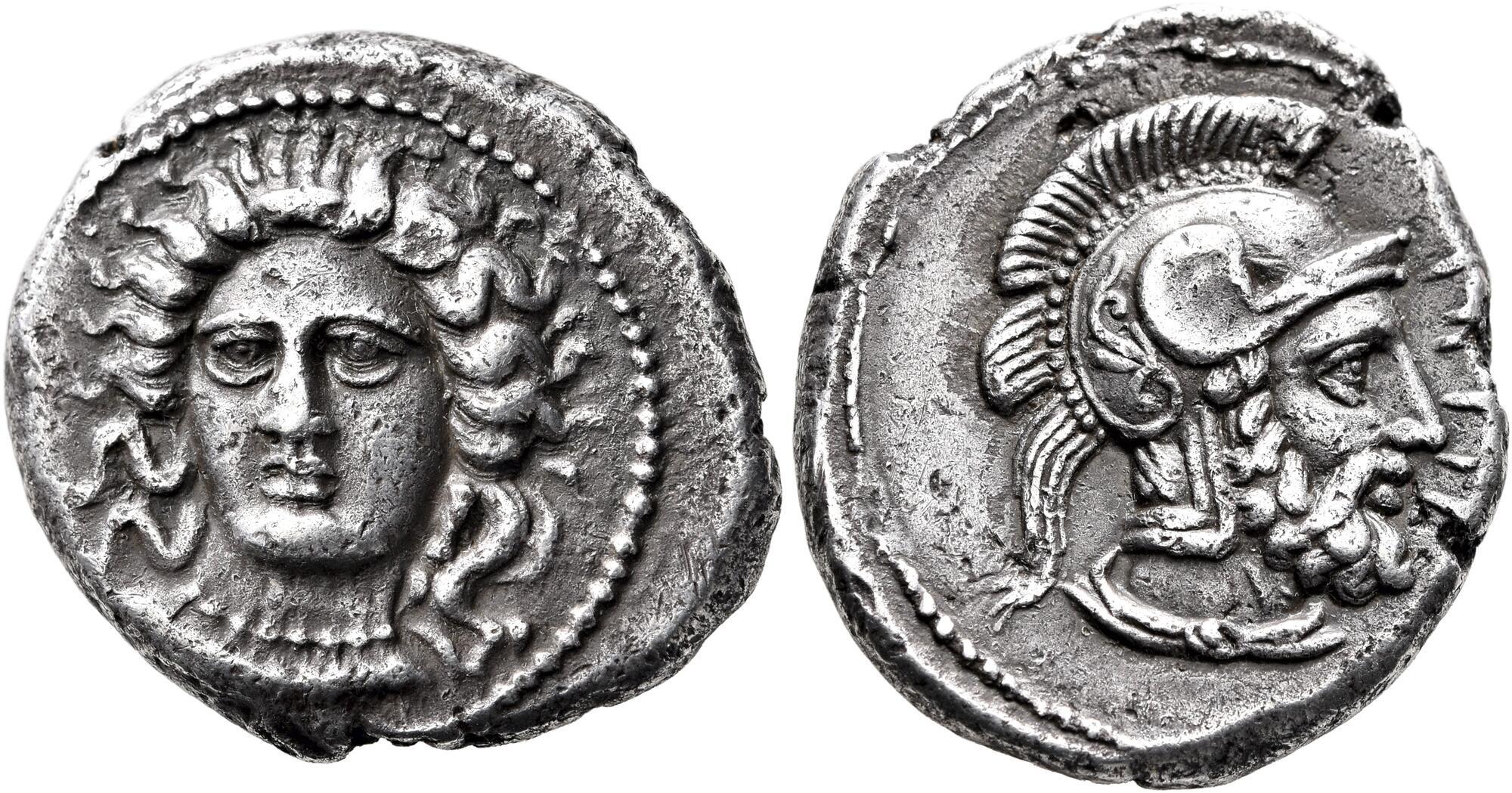Revision as of 19:59, 1 August 2023
400 BCE - 380 BCE | EΣTFEΔIIVΣ
Overstriking coin
SO_1764_-_Aspendus_(didrachm_athletes-slinger).png
[1]
Overstruck variety
Tarsus Female head-Ares.jpeg
[2]
|
|
Sale(s)Sale(s) ᵖ:
|
Baldwin, 34, 13 Oct. 2003, 141
|
|
|
|
Description
| ObverseInscription or printing placed on the obverse.:
|
Two naked athletes wrestling. Border of dots.
|
ReverseInscription or printing placed on the reverse.:
|
EΣTFEΔIIVΣ (Greek) Slinger advancing right. In right field, triskeles and BA:FE. All within an dotted incuse square.
|
Mint and issuing power
| MintIdentifies the place of manufacture or issue of a numismatic object.:
|
Aspendus
|
Ancient regionAncient region.
|
Pamphylia
|
Modern countryModern country: Turkey
|
AuthorityIdentifies the issuing power. The authority can be "pretended" when the name or the portrait of X is on the coin but he/she was not the issuing power. It can also be "uncertain" when there is no mention of X on the coin but he/she was the issuing power according to the historical sources:
|
|
Chronology
| FromIdentifies the initial date in a range assigned in a numismatic context. 400 BCE toIdentifies the final date in a range assigned in a numismatic context.. 380 BCE
|
Classical 480-323 BC  periodTime period of the numismatic object. periodTime period of the numismatic object.
|
Physical description
MetalThe physical material (usually metal) from which an object is made.: Silver 
|
WeightWeight of the numismatic object (in grams). in grams: 10.8510.85 g <br />10,850 mg <br />
|
DenominationTerm indicating the value of a numismatic object. Examples: tetradrachm, chalkous, denarius.: didrachm 
|
|
|
|
|
References
Description
| ObverseInscription or printing placed on the obverse.:
|
Female head turned slightly left, wearing earring and necklace.
|
ReverseInscription or printing placed on the reverse.:
|
Legend in Aramaic Male head (Ares?) left, wearing Crested Attic helmet (visible on the obverse: traces (locks of hair) below the feet of the wrestlers).
|
Mint and issuing power
Chronology
| FromIdentifies the initial date in a range assigned in a numismatic context. 373 BCE toIdentifies the final date in a range assigned in a numismatic context.. 368 BCE
|
Classical 480-323 BC  periodTime period of the numismatic object. periodTime period of the numismatic object.
|
Physical description
References
References
- ^ Breitenstein, Niels (1955), Sylloge Nummorum Graecorum: Royal Collections of coins and medals. Danish National Museum, 31, Lycia-Pamphylia.
- ^ Sylloge Nummorum Graecorum. Sammlung v. Aulock. Pamphylien. 11 Heft (n° 4477-4893), Berlin, 1965.
- ^ Levante, Edoardo [with the collaboration of Peter Weiss] (2001), Sylloge nummorum graecorum. France. 3, Département des monnaies, médailles et antiques : Pamphylie, Pisidie, Lyaconie, Galatie, Paris-Zürich, Bibliothèque nationale de France-Numismatica Ars Classica, XXXIV + 293 p. and 146 pl.
- ^ Tekin, Oguz (2000), "Aspendian 'Wrestlers' : an iconographic approach", in: Casabonne, Olivier (ed), Mecanismes et innovations monetaires dans l'Anatolie achemenide : numismatique et histoire : actes de la table ronde internationale d'Istanbul, 22-23 mai 1997, Paris, Institut français d'etudes antoliennes d'Istanbul, p.159-169, pl. 27-28
- ^ Breitenstein, Neils (1956), Sylloge Nummorum Graecorum: Royal Collections of coins and medals. Danish National Museum, 34, Lycaonia-Cilicia.
- ^ Sylloge Nummorum Graecorum. Sammlung v. Aulock. Kilikien. 13 Heft (n° 5413-6098), Berlin, 1966.
- ^ Levante, Edoardo (1993), Sylloge nummorum graecorum. France 3. Cabinet des Médailles : Cilicie, Paris, BnF, xviii + 274 p., 103 pl.
- ^ Moysey, Robert A. (1986), "The Silver Issues of Pharnabazos and Datames from the Mint of Tarsus in Cilicia", American Numismatic Society Museum Notes, 31, p. 7-61, pl. 1-5.

